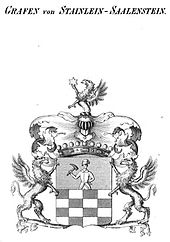Johann Gottlieb Eduard von Stainlein
Johann Gottlieb Eduard Graf von Stainlein (born March 16, 1785 in Hof , † January 23, 1833 in Pest ) was a Bavarian diplomat .
Life
He was the only son of the margravial Bavarian judicial advisor Friedrich von Stainlein. Stainlein entered the diplomatic service of the Electoral Palatinate of Bavaria and worked from 1806 as a secretary, later as a legation counselor at the embassy of the new Kingdom of Bavaria in Vienna and at the imperial court there.
1815 it rose King Maximilian I. Joseph in the baron and appointed him the following year to the local envoy and Minister Plenipotentiary of Bavaria. He signed a. a. 1820 the Vienna Final Act of the German Confederation . The king held Stainlein in high esteem, who particularly stood out in the negotiations on the 1824 marriage of Princess Sophie Friederike of Bavaria to Archduke Franz Karl of Austria . The bride was the daughter of King Max I. Joseph and the spouses should the parents of the future Emperor I Franz Joseph are.
Stainlein, of Protestant faith, married Susanne von Hellenbach (1794–1881) around 1817 from an old Lutheran noble family from Hungary. Her father Joseph von Hellenbach was the last male representative of his family line and the couple therefore inherited large estates in Hungary.
In 1825 the Bavarian King Max I Joseph died, his successor King Ludwig I dismissed Stainlein from his post in Vienna in 1826 due to disagreements and he left the civil service. At the same time he acquired the Hungarian indigenous community and withdrew into private life. Most of the time he stayed on the estates in Hont County .
In 1830 the family was raised to the Bavarian count status, with the additional title of Saalenstein . It was not until 1841, years after Stainlein's death, that the dignity of count was recognized for the widow and children in the Kingdom of Hungary .
Stainlein died on January 23, 1833, in Pest, of nervous fever (typhus).
The count was the royal Bavarian chamberlain and holder of the Grand Cross of the Order of Merit of the Bavarian Crown . He also wore the Austrian Order of the Iron Crown 1st Class (combined with the Privy Council title ), the Commander of the Austrian Order of Leopold and the Prussian Order of the Red Eagle III. Class.
He had several children with his wife. The son Ludwig von Stainlein (1819–1867) gained fame as a musician and composer and in 1858 converted to Catholicism. The daughter Malwina (1822–1878) married Heinrich Wilhelm Joseph von Wilczek, son of the Austrian politician Friedrich von Wilczek (1790–1861).
literature
- Ernst Heinrich Kneschke : German count houses of the present. Volume 3, pp. 380-381. (Digital scan)
- Friedrich August Schmidt: New necrology of the Germans. Volume 11 (1833), Volume 2, p. 909. (Digital scan)
- Pierer's Universal Lexicon. Volume 16, Altenburg, 1863, p. 675. Digital view
Web links
- Document collection on the person, in the Bavarian main state archive in the German digital library
- Letter of recommendation from Stainlein to the King, regarding Beethoven's Missa Solemnis (1823)
Individual evidence
- ↑ Ludwig Schönchen: Ludwig Graf Stainlein von Saalenstein: a sheet of memory. Munich, 1868, p. 3. (digital view)
- ↑ PDF document on the Vienna Final Act of 1820
- ↑ Ludwig Schönchen: Ludwig Graf Stainlein von Saalenstein: a sheet of memory. Munich, 1868, p. 4. (digital view)
- ^ Writings of the Literarisches Verein in Wien: Letters to Mrs. Christine von Stransky , Volume 7, Vienna, 1907, p. 410; (Detail scan)
- ^ Daily newspaper for the district capital Augsburg. No. 259, from September 16, 1830
- ^ Ernst Heinrich Kneschke: New General German Adels Lexicon. Volume 8, p. 596, Leipzig 1868. (digital scan)
- ↑ courier on the Danube: Newspaper for Lower Bavaria. No. 34, Passau, February 8, 1833. (digital scan)
- ^ Georg Ferdinand Döllinger: Collection of the existing ordinances in the area of the internal state administration of the Kingdom of Bavaria. Volume 20, p. 27, Munich 1839. (digital scan)
- ^ Frankfurter Ober-Postamts-Zeitung. No. 83 of March 24, 1825 (digital scan)
| personal data | |
|---|---|
| SURNAME | Stainlein, Johann Gottlieb Eduard von |
| BRIEF DESCRIPTION | Bavarian diplomat |
| DATE OF BIRTH | March 16, 1785 |
| PLACE OF BIRTH | court |
| DATE OF DEATH | January 23, 1833 |
| Place of death | pest |

